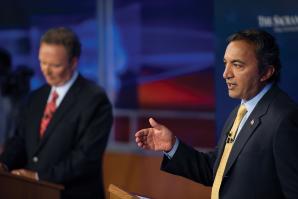In 1970, California’s Legislature was declared the model for America, and it was an honor well deserved. It had “all the right characteristics that a legislature should have.” In the mid-’50s California purged the legislative process of lobbyists such as Artie Samish who once boasted he was “governor of the Legislature.” Samish picked the men (all men in those days) who were elected, and he ran the place.
By the 1960s, legislatures around the country were wakening from their long naps as political backwaters. The idea the federal government had all the answers was fading, and states were once again seen as laboratories for democracy, exactly what the founding fathers wanted them to be.
California led the way. It had a professional staff writing and analyzing bills; members were paid decent salaries; and legislative service attracted some of the best and brightest. Most importantly, the legislators of the 1960s and 1970s knew how to govern; they knew how to make deals.
But today’s Legislature is blamed for most everything wrong with California. The two parties cannot get along. They cannot govern. They do nothing but fight between themselves, and the public has pretty much turned off to the legislative process. The Legislature’s approval rating wobbles between 10 and 20 percent, depending upon the poll — the only approvals these days seem to come from staffers and blood relatives.
So what went wrong; what caused the decline; and can it be turned around? In liberal circles it is fashionable to blame Proposition 13 and the emergence of direct democracy for all the ills. Those cranky citizens have made it impossible for legislators to govern, complain the liberals.
This is an odd argument, and it’s also not true. The people have had the power to make their own laws for a century. They passed Proposition 13 in 1978 after nearly a decade of failure by legislators to provide property tax relief. Despite the fact this state becomes more democratic every year, the voters have refused opportunities to raise taxes, even on the rich or on Big Oil and Big Tobacco. They have purposely limited the Legislature’s discretion in areas such as law enforcement and school finance.
So the voters have taken out their anger at a dysfunctional legislature by clipping its wings, but their exercise of direct democracy is not the reason for the dysfunction, it is the product of the dysfunction. The reasons go deeper.
One reason often cited is term limits. There is some justification. For 20 years we have operated under term limits that allow six years of service in the Assembly. (Senators can have eight years of service.) Six years is too short, and that is one reason for generally weak leadership in the Assembly. But help is on the way. At the next statewide election, an initiative will give voters the option of allowing a legislator to serve 12 years in either house. So you can serve one 12-year term in either the Assembly or the Senate. That will go a long way to alleviate the power vacuum, especially in the Assembly, that term limits bring about.
A number of acute observers have noted that campaign finance
reform is also a major villain. That may sound odd, but in 2000
legislators themselves placed a ballot measure to limit direct
campaign contributions. The measure was an alternative to an
existing campaign finance initiative opposed by politicians.
As with everything else, there were unintended consequences. The leadership was no longer able to raise huge sums of money for individual legislators. That reduced the clout of the leaders and made it harder for the leaders to impose their will on members.
Power always flows somewhere; in this case, it flowed to the interest groups. They are able to spend unlimited amounts of money through independent expenditures, and that has replaced legislative leaders as the source of campaign funds. This means these special interests call the shots, and the consequence is apparent every day. Democrats are unable to cross the powerful public employee unions who bankroll their campaigns, and Republicans are scared to death of the anti-tax groups who threaten them if they wander off the reservation.
So you have a legislature with weak leaders and members unwilling and unable to buck the special interests who got them elected.
But changes are coming. New districts created by the California Citizens Redistricting Commission rather than sweetheart districts drawn by legislators themselves may inject some democracy back into the process and make legislators more responsive to their voters, not just the moneyed interests groups.
And the new open-primary law with a runoff of the top two contenders regardless of party should also lead to the election of legislators more attuned to all the voters in their districts, not just ideological activists who dominate the old closed-primary system.
Whether these two reforms, whose impact will be seen in the 2012 election, actually work to improve the Legislature is an open question. But given the public’s unhappiness with legislative performance today, structural reforms may be the best hope and only way to restore California’s Legislature to the glory that it once knew.
Tony Quinn is co-editor of the California Target Book, a
nonpartisan analysis of legislative and congressional
elections.
Recommended For You

Hoops & Hurdles
The struggle to sell Jerry Brown's tax measure
If the people of California won’t vote to tax Big Tobacco or Big Oil, why does Gov. Jerry Brown think they’ll vote to tax themselves?

Is Sacramento Permanently Democratic?
Voter trends with lasting effects
The 2012 election may have spelled the end for a 30-year boomlet of Republican legislative and congressional representation in Sacramento.


